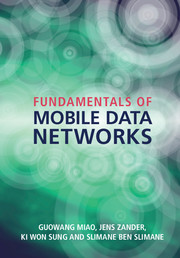Book contents
- Frontmatter
- Contents
- Preface
- Acronyms
- Notations
- 1 Introduction
- 2 Wireless network models
- 3 Medium access control
- 4 Scheduling
- 5 Principles of cellular systems
- 6 Transmitter power control
- 7 Interference management
- 8 Association and handover
- 9 Energy-efficient design
- 10 Long term evolution
- 11 Wireless infrastructure economics
- About the authors
- Index
- References
1 - Introduction
Published online by Cambridge University Press: 05 March 2016
- Frontmatter
- Contents
- Preface
- Acronyms
- Notations
- 1 Introduction
- 2 Wireless network models
- 3 Medium access control
- 4 Scheduling
- 5 Principles of cellular systems
- 6 Transmitter power control
- 7 Interference management
- 8 Association and handover
- 9 Energy-efficient design
- 10 Long term evolution
- 11 Wireless infrastructure economics
- About the authors
- Index
- References
Summary
Historical perspective on radio resource management
As J. C. Maxwell had predicted in the 1850s, wireless transmission of electrical energy was feasible. Several decades later Heinrich Hertz managed to experimentally verify Maxwell's daring ideas with his award-winning experiment in 1888. He was able to demonstrate that his 600 MHz transmitter was capable of producing a spark in his simple receiver a few meters away in his laboratory. Although several scientists and inventors would like to claim the fame of inventing radio as we know it today, it took an engineer to bring this groundbreaking research into practical use. The Italian pioneer Guglielmo Marconi was the first to make practical and commercial use of the so-called Hertzian waves. After some initial experiments on his father's estate in 1895, his wireless apparatus gradually became a commercial success. It eventually made Marconi the first, but certainly not the last, millionaire in the wireless business. From humble beginnings, transmitting messages a few hundred meters in his first experiments, in 1901 he was finally able to demonstrate wireless communication across the Atlantic Ocean from Poldhu in Cornwall, England, to Newfoundland, Canada. In the decades to follow, wireless communications became an essential technology onboard ships. The early 1920s saw the advent of radio broadcasting, bringing wireless receivers into every home. We know what happened later—wireless has created a deep impact in our daily lives through success stories such as TV broadcasting, worldwide shortwave communication, satellite communications, and in recent decades mobile telephony and wireless and mobile Internet access.
The latest chapter in this story started to be written in the early 1980s with the commercial success of automated mobile telephony and mobile data. Examples of so-called first generation mobile telephone systems are the NMT system in Scandinavia (1981), AMPS in the USA (1984), TACS in the UK (1984) and other systems. These systems were targeting limited markets, terminals were expensive and they never reached very high user penetrations. The first-generation systems were analog designs—only the switching logic relied on digital technology.
It took another decade and the introduction of global standards for digital mobile systems to put a cellular phone in almost every person's hands.
- Type
- Chapter
- Information
- Fundamentals of Mobile Data Networks , pp. 1 - 11Publisher: Cambridge University PressPrint publication year: 2016



